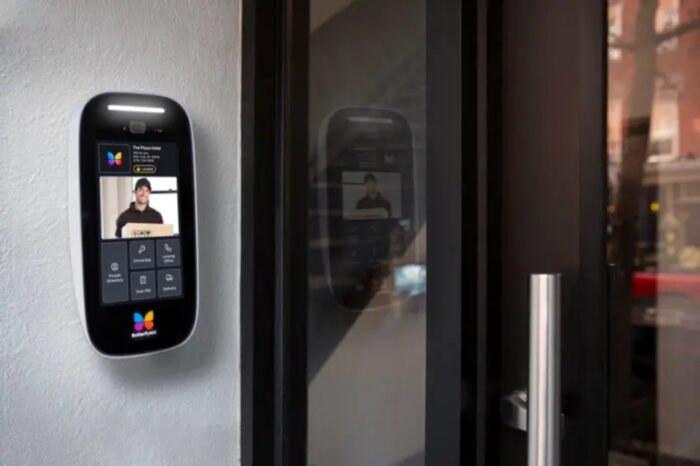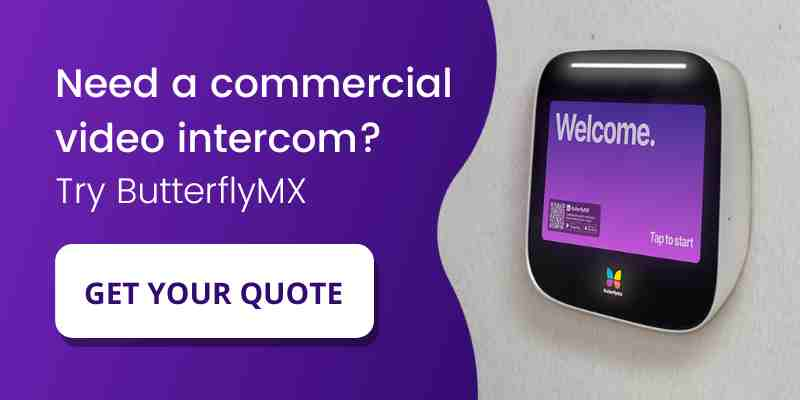Key takeaways
- A commercial intercom system with door release enables tenants to remotely unlock doors or gates for visitors, enhancing convenience and security.
- These systems operate by allowing tenants to communicate with visitors via a base station at the entrance and, upon verification, press a button to unlock the door remotely.
- Door release mechanisms typically utilize electronic locks (electric strikes) or magnetic locks (maglocks), each offering distinct security features and installation requirements.
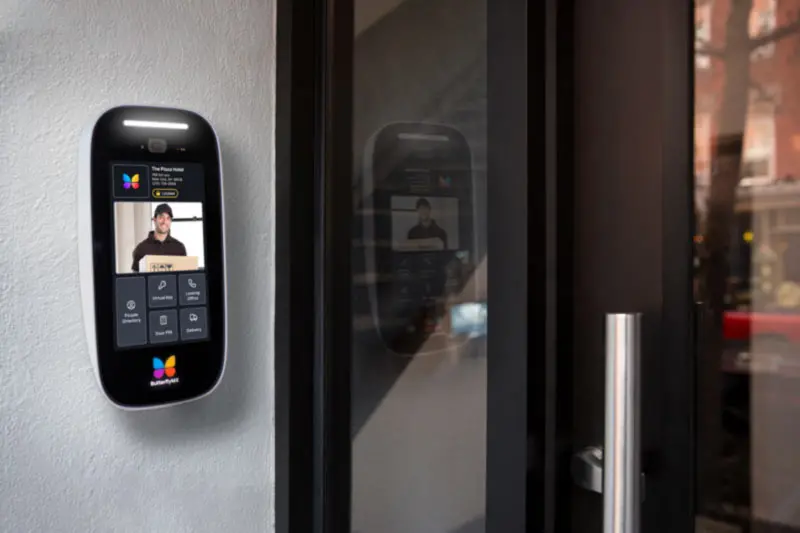
How do visitors access your commercial building? If you don’t have a commercial intercom system installed at your property, it’s time to invest in one.
One of the most important considerations when choosing a commercial intercom is whether it will have a door release mechanism. Your best bet is to choose a commercial intercom system with door release.
But what is a door release system, how does it work, and why is it so important? Read on to learn more about intercoms with a door release mechanism and why your commercial intercom should have one.
This post covers:
- What is a commercial intercom system with door release?
- How a commercial intercom with door release works
- Types of door locking mechanisms
- Wiring for door release systems
- How to choose the right commercial intercom for your business
What is a commercial intercom system with door release?
A commercial intercom system with door release is a building access system that enables tenants inside the building to open the door or gate remotely for visitors. The tenant doesn’t have to be at the entrance to open the door — instead, they can press a button to unlock it remotely.
The door release mechanism is the component of the intercom system that enables remote access. Without a door release, the commercial intercom would only allow the tenant and the visitor to communicate — the tenant wouldn’t be able to open the door for their guest.
How a commercial intercom system with door release works
A commercial intercom system with door release works by empowering a tenant within the building to unlock a door or gate remotely with the push of a button.
When a guest arrives at a commercial building with an intercom system, they first use hardware installed at the entrance (a base station) to call the tenant they’re visiting. The tenant is then notified of the guest’s arrival through the commercial intercom substation, which can either be a device installed in their suite or their smartphone.
After the tenant answers the call, they can decide whether to grant the visitor property access. If they want to grant access, they simply press the ‘door open’ button on the intercom substation.
When the tenant presses that button, the intercom sends a signal to the door release system. Then, the door release system unlocks the door, allowing the visitor to enter the building.
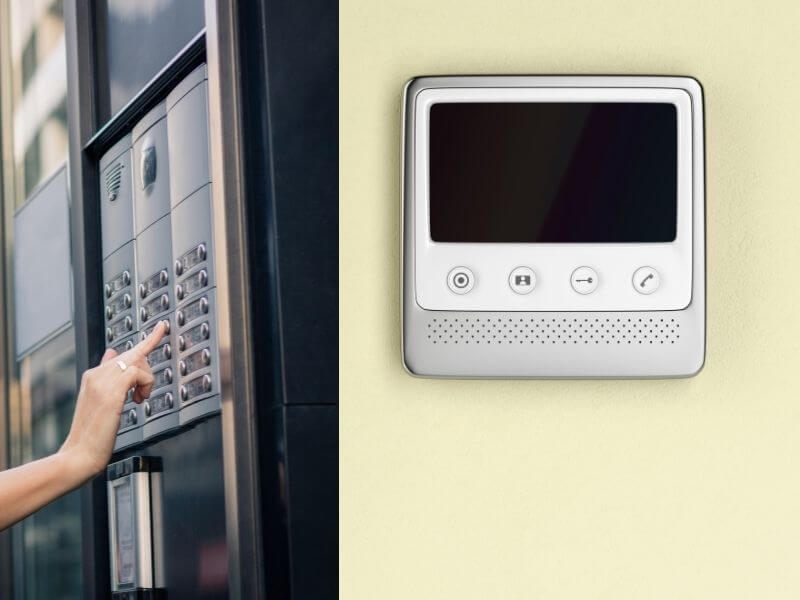
Types of door locking mechanisms
One important consideration when purchasing or installing a multi-tenant commercial intercom with a door release is the door locking mechanism. The lock on your door or gate determines how the door release system operates. If you don’t already have a compatible lock, you’ll need to select and install one.
There are two types of commercial door locking mechanisms:
The primary difference between electric strikes and magnetic locks is that magnetic locks are fail-safe while most electronic locks are fail-secure. That said, they share the same purpose: to enable property access to those who need it while prohibiting access to those who don’t.
Electronic locks (or electric strikes)
An electronic lock is a mechanical device powered by electricity. Electric strike locks are installed in the door frame, replacing the lock strike plate.
An electric strike only receives electrical power when the door needs to be unlocked. At all other times, there’s no electricity flowing to the lock. To unlock a door with an electric strike, you have to provide a power source. And that’s where a door release system — such as a commercial intercom — comes in.
When a tenant presses the ‘door open’ button, the intercom system sends power to the electric lock, which allows the lock’s latch to move and the door to open.
Magnetic locks (or maglocks)
In contrast to electric strike locks, magnetic locks are magnetic devices that require electricity to stay locked. A magnetic lock (also called a maglock) consists of a magnet and a metal plate. In most installations, the maglock is aligned with the door frame, usually positioned at the top of the frame.
A maglock requires a constant power supply to remain locked. Electricity passes through the maglock’s magnet, which creates a charge that attracts it to the magnetic plate and keeps the door locked.
To unlock the door, you must remove the electricity flowing through the maglock. A door release system sends a signal that shuts off power to the maglock, which allows the door to open.
Wiring
Every commercial intercom requires some amount of wiring. Wired commercial intercoms need wiring from the base station to every substation throughout the building, while commercial wireless intercom systems don’t. The type of intercom you choose for your commercial building will determine which type of door release system you’ll need.
The door release in a commercial door intercom system can either be wired or wireless.
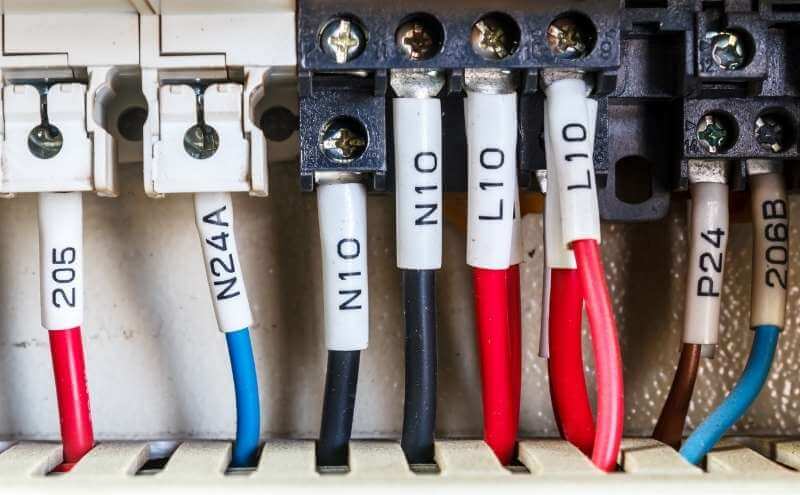
Wired door release systems
If you have a wired door release system, you’ll have to run wiring to every suite in your commercial building. That wiring connects the in-unit hardware (the intercom substations) throughout the building to the intercom base station and the door release system.
To open the door or gate, tenants in your building must push the ‘door open’ button on their substation. Pushing that button sends a signal to the door release system, which tells it to unlock the electric strike or magnetic lock.
Wireless door release systems
If you have a wireless door release system, you don’t have to run wiring throughout the building. Wireless intercom systems for commercial buildings operate with wireless substations (either hardware installed in every unit or tenants’ smartphones with a mobile app).
When a tenant wants to open the door for a visitor, they press a designated button on the substation. That sends a digital signal to the door release system, telling it to unlock the door.
How to choose the right intercom with door release for business
Are you planning to install a commercial intercom for your business? First, you’ll have to make a few decisions to determine which intercom is right for your office building.
The top four factors to consider when purchasing a commercial intercom system are:
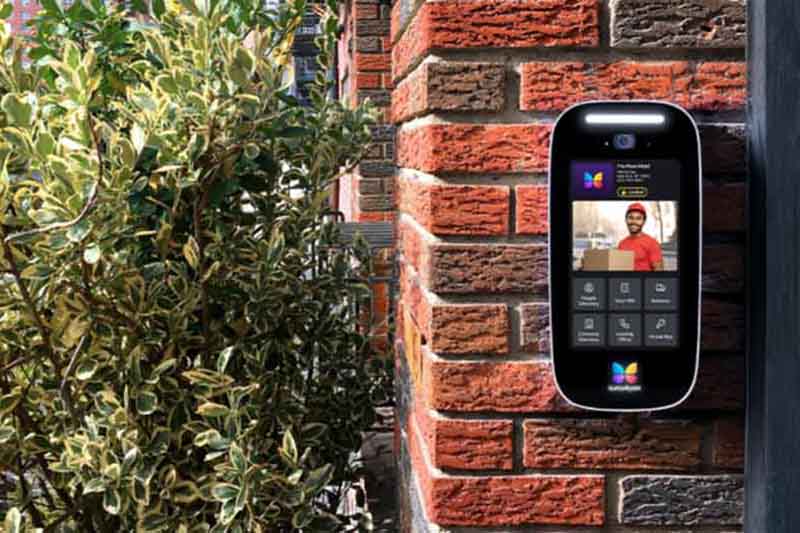
1. Functionality
First and foremost, you’ll have to decide whether the door release function is important to you.
Do you want your tenants to be able to grant access remotely? If so, you need a commercial intercom with door release.
Commercial tenants prefer intercom systems with a door release over office intercoms that only enable communication because a door release adds convenience. When a tenant has a visitor or a delivery, they won’t have to manually let them into the building — all your tenant has to do is push a button to open the door or gate.
If you do want a commercial intercom system with door release, you’ll have to install the right type of lock: an electric strike or a magnetic lock. The type of door at your building’s entrance may affect which lock you can install. Make sure the intercom works properly with the lock you choose.
2. Intercom wiring
The next factor to consider is the wiring. Do you want a wired or a wireless commercial intercom with door release?
Here’s why you should choose a wireless intercom system for business:
- Wired intercoms require you to install hardware in every suite. The cost of installing and maintaining all that hardware adds up quickly.
- Running wiring throughout the building is expensive and complicated. You’ll save money on the installation if you go wireless.
- Tenants prefer wireless intercoms. Your tenants prefer the convenience of using their smartphones wherever they may be to grant property access. Instead of in-unit intercom hardware installed on a wall in their office.
3. Video capabilities
One of the most important decisions to make when choosing a commercial intercom is whether you want video capabilities.
A commercial video intercom system with door release has a built-in camera to enable video calling between tenants and visitors. The ideal commercial video intercom lets tenants use their smartphones to video chat with visitors and grant them access.
The most significant benefit of a video intercom with door release is that tenants can see who’s requesting access before letting them in. This adds an extra layer of security that your tenants and their employees will appreciate.
4. Front desk station capabilities
The last decision to make is whether you want to integrate your intercom with front desk station software.
A front desk station empowers you to easily manage visitor access right from your property’s front desk — or from anywhere else in the world.
What’s more, front desk software allows you to view a live video feed of your property’s intercoms in one place. Moreover, it streamlines communication and enhances security by empowering you to speak directly to your visitors and tenants.
